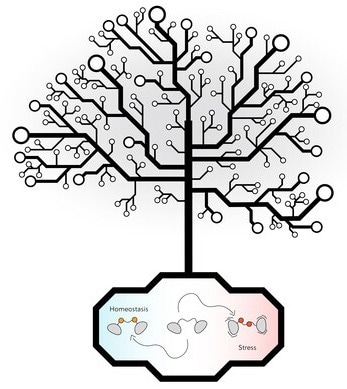Autophagy, commonly known as “self-eating,” is a cellular quality control mechanism that relieves the cell of protein aggregates and damaged organelles. This system is inert under ordinary conditions and is only activated in the presence of persistent cellular stress.
 Cellular stress and homeostasis in the tree of life. Image Credit: ©Picchianti/GMI.
Cellular stress and homeostasis in the tree of life. Image Credit: ©Picchianti/GMI.
The Austrian Academy of Sciences’ Gregor Mendel Institute of Molecular Plant Biology (GMI) and the Max Perutz Labs have discovered a molecular switch that governs autophagy in plants. They show that this regulating mechanism is conserved in eukaryotes by combining evolutionary research with a mechanistic experimental method. The findings were published in the EMBO Journal on February 10th, 2023.
Sustained cellular stress caused by disturbances in cellular homeostasis reduces cell fitness and longevity. Cellular stress can occur when ribosomes clash when translating defective mRNAs, for example. Cells get overwhelmed because of unfinished and poorly produced protein products, which form harmful protein aggregates. Cells can use an array of quality control (QC) mechanisms to restore equilibrium during cellular stress.
Cells in the endoplasmic reticulum (ER), the cellular hub for protein production and transport, activate an ER-specific autophagic pathway known as “ER-phagy” to selectively eliminate damaged ER.
When ribosomes collide on the ER, another QC mechanism known as “UFMylation” collaborates with ER-phagy to remove incompletely produced proteins from the ER membrane. UFMylation is an enigmatic QC pathway centered on a protein post-translational alteration that resembles ubiquitin, and its activities are unknown.
Recently, scientists at the Vienna BioCenter have discovered an old molecular switch that controls ER-phagy. Employing evolutionary biology and mechanistic experimentation, the researchers show that competition between two ubiquitin-like molecules, UFM1 and ATG8, causes a molecular switch in the master regulator C53, triggering ER-phagy.
UFMylation and ER-phagy: Bridging the pathways through similar, but distinct binding
Our previous work suggested that C53 could link the two quality control mechanisms, ER-phagy and UFMylation. However, the molecular nature of this bridge remained unclear.”
Yasin Dagdas, Study Co-Corresponding Author and Group Leader, Gregor Mendel Institute of Molecular Plant Biology
The authors demonstrated that C53 interacted with the protein ATG8, a ubiquitin-like participant in the autophagy pathway, via non-canonical ATG8 Interacting Motif (AIM) sequences in C53’s intrinsically disordered region in their study, which was published in 2020.
These non-canonical AIMs were dubbed “shuffled AIMs” (sAIMs) by the researchers. They also discovered that UFM1, a ubiquitin-like molecule that is chemically linked to protein substrates, competes with ATG8 for C53 binding. Three sAIM motifs and one canonical AIM (cAIM) are found in the C53 intrinsically disordered region.
“Now, using Nuclear Magnetic Resonance spectroscopy, we showed that C53 sAIM1 and sAIM2 were UFM1’s preferred binding motifs. On the other hand, ATG8 had a considerably higher preference for the cAIM motif on C53, as expected for a canonical binding sequence. Yet, ATG8 also interacted with sAIM1 and sAIM2, albeit with a lesser affinity,” states Elif Karagöz, co-corresponding author and Max Perutz Labs Group Leader.
Tinkering with the binding shifts the balance between the pathways
After discovering UFM1 and ATG8 binding preferences in the intrinsically disordered region of C53, the researchers wanted to verify their function by replacing the sAIM motifs in C53 with normal cAIM sequences.
By introducing these mutations into Arabidopsis thaliana, the scientists considerably enhanced ATG8’s binding affinity to C53 while decreasing UFM1’s binding. This resulted in the continual firing of the C53 autophagy pathway, making the plants extremely vulnerable to ER stress. Thus, the researchers revealed that sAIMs are required for controlling C53-mediated ER-phagy and, as a result, ER stress tolerance.
UFMylation is highly conserved in eukaryotes
With the assistance of Thomas A. Richards’ group at the University of Oxford, the researchers examined the evolutionary path of C53, sAIMs, and UFMylation components. They found that C53-mediated autophagy is conserved across eukaryotes and that C53 developed alongside the UFMylation pathway.
Molecular remnants or the presence of related proteins suggested that fungi, certain algae, and some eukaryotic parasites had a subsequent loss of UFMylation and/or C53.
Our results show that C53 is very much linked to UFMylation, suggesting a highly conserved functional link. This applies to sAIMs in particular: In species that have lost UFM1, their C53 also lost its sAIMs.”
Yasin Dagdas, Study Co-Corresponding Author and Group Leader, Gregor Mendel Institute of Molecular Plant Biology
The scientists went on to show that the unicellular algae Chlamydomonas reinhardtii had a functional UFMylation pathway with the support of Silvia Ramundo’s group at GMI. Earlier claims that the UFMylation pathway was involved in the evolution of multicellularity were contradicted by this discovery.
A powerful QC mechanism regulated by an ancient molecular switch
Taken together, our findings indicate that the non-canonical ATG8 interacting motifs evolved to allow another ubiquitin-like protein, UFM1, to bind C53 and keep it inactive under homeostatic conditions.”
Yasin Dagdas, Study Co-Corresponding Author and Group Leader, Gregor Mendel Institute of Molecular Plant Biology
This mechanism is required to stop cells from “eating” healthy cellular components.
Moreover, Dagdas feels that because fungi and some eukaryotic parasites lost the UFMylation pathway more recently in evolution, these organisms must have acquired equivalent systems to perform the same purpose, namely sustaining ER homeostasis.
Dagdas infers, “Identifying such mechanisms in fungi, but also in parasites affecting plants, animals, and even humans would open up potential translational avenues for new drugs.”
Source:
Journal reference:
Picchianti, L., et al. (2023) Shuffled ATG8 interacting motifs form an ancestral bridge between UFMylation and autophagy. The EMBO Journal. doi.org/10.15252/embj.2022112053.